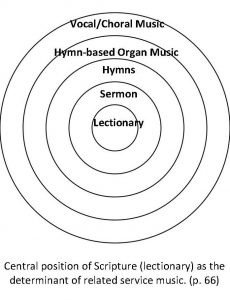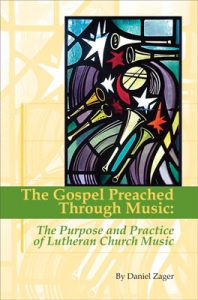Daniel Zager has served as organist and director of music for several Lutheran congregations. He was a member of the Hymnody Committee for Lutheran Service Book. Zager has served as editor of CrossAccent: Journal of the Association of Lutheran Church Musicians and of the Journal of the Good Shepherd Institute.
If the Word of God is the sword of the Spirit, does it matter what kind of music we use in our worship? What kind of music is best for Lutheran worship? Such questions are at the heart of many discussions these days regarding music styles in worship. Unfortunately, worship planners don’t always wrestle with these questions and their implications when charting a musical course for their congregations. This short book leads the worship planner through the thought process of what is the best music to use for Lutheran worship. The author states up front, “This book is also prompted by my belief that Lutheran church musicians must think more carefully about the purpose of music in worship” (p. ix).
As we make decisions about music in worship, it is important that we ask the right questions.
The debate about music in Lutheran worship has sometimes been framed around questions of what is permissible, but it may be more useful to frame the issues around a different question: Is this music an apt and fitting choice? Does this music – and here I really mean music, not text – stand well alongside Lutheran theology? Is this music a good match for Lutheran theology as it is expressed in our orders of service, preaching, and hymnody? Thus, we ask better questions – and obtain better answers – when we ask not what is permitted but rather what is truly fitting for the proclamation of God’s Word. With the Apostle Paul, we might say: “‘All things are lawful,’ but not all things are helpful. ‘All things are lawful,’ but not all things build up” (1 Cor 10:23). (p. 3)
Zager gets his points across in three simple chapters.
- The Purpose of Lutheran Church Music
In one Table Talk discussion, Martin Luther explained that God has preached the gospel through music too (p. 13). (Thus, the title of the book.) Luther understood that music is not a neutral medium when it carries God’s Word. Music has a powerful effect on people, so we will strive to use music that best carries God’s Word to the hearts of God’s people. “Preaching and music operate on the same plane and strive for the same goal – both proclaim the Word of God” (italics original, p. 16). This is not a matter of manipulation (as Evangelicalism uses music). It is a matter of giving expression to the true meaning of the Word. For example, the music in our Good Friday services is a different style than the music of Easter morning. Proclaiming the gospel is the greatest praise we can give God. “We err when we consign music only to the category of praise; praise is not the sole or even primary purpose of music in Lutheran worship” (p. 9).
- The Practice of Lutheran Church Music
Practically speaking, what is the best type of music for proclaiming the gospel? Instead of giving a simple opinion or answer, Zager takes a look at the history of worship in the Lutheran church. He demonstrates how three leading Lutheran musicians (Praetorius, Schütz, Bach) in the three centuries after Luther put his principles into practice. The musician who reads this book will enjoy studying the many examples of music scores showing how those three composers used the art of music to give expression to the message of Scripture. Zager is not suggesting that genuine Lutheran churches should only use music that is 300 years old or older, but that every genuine Lutheran Church would be wise to follow the principles those masters followed.
Music, all by itself, does communicate a message. The advertising and entertainment industries certainly understand this. Just think how the soundtrack in a movie lets us know that something bad is going to happen even before the heroine opens the door to the dungeon. What music we use in worship should be determined by what we are trying to accomplish.
Because of their Arminian theology, the entire purpose of Evangelical worship is to manipulate the emotions to get the desired response from the people, whether that be a commitment to Christ, more sanctified living, or larger offerings. The goal of their worship is not to proclaim law and gospel and offer the Sacraments. It’s not surprising, therefore, that Evangelicalism has adopted the musical styles of the entertainment industry. Lutherans need to be aware of the purpose of Evangelicalism’s contemporary Christian music before they cut and paste it into their worship (pp 36-39).
Asking hard questions about musical aspects of “contemporary” worship has been rare in current Lutheran practice. For example, what does it mean when … the instrumentation of the “praise band” is identical to that of a standard rock band? … What does it mean when singers in the “praise chorus” are amplified in such a way that they overshadow the singers of the congregation? What does it mean when the melodic line of a “praise song” is rhythmically complex, heavily syncopated, and soloistic instead of rhythmically straightforward and congregational? (p. 37)
“The very real need for specific ethnic music should not be inappropriately intertwined with a baby-boomer yearning for pop musical expressions rooted in the 1960s and 70s” (p. 38).
- Choices in Lutheran Church Music
Once a worship planner understands the purpose of music in Lutheran worship and has learned from the excellent examples of the past, he is prepared to make the practical decisions of what music to use. “One’s understanding of the purpose of Lutheran church music (the why how of church music) will ultimately manifest itself in one’s choices of music (the what of church music)” (p. 63).
Zager clearly advocates the use of the organ in Lutheran worship because of its efficiency (only one person required to play it), because of its versatility (able to accompany a soloist or lead a congregation along with a brass group), and because there is such a large repertoire of hymn-based organ music. Still, he is not suggesting that the organ is holier than any other instrument.
Attendant music during our worship (pre- and post-service, offertory, etc.) especially helps to proclaim the gospel when it based on a hymn tune. Hearing the tune will recall the message of the hymn.
The perception of a well-known hymn melody leads to a recall of the associated hymn text, which leads the listener to a recognition of the theological content proclaimed by that hymn text, which itself is standing in relationship to the lectionary readings for a specific day in the church year. Thus, there is a continuum linking organ setting to hymn melody to hymn text to lectionary reading, which in turn prompted the selection of that hymn, and consequently the selection of that organ hymn prelude. (p. 69)

Zager strongly encourages integrating the music with the lessons of the day and the theme of the service. Such a unified service will help to impress the message upon the hearts and minds of the worshipers. Such a unified service requires planning and effort.
Pastors and organists should choose hymns purposefully on the basis of their textual ability to complement the readings appointed in the lectionary for each Sunday. Planning should take place well in advance, working by season of the church year, so that the organist has the opportunity to locate and learn organ settings based on the hymns for each Sunday. (p. 69-70)
Zager concludes,
When we choose congregational hymns, vocal and choral music, organ and other instrumental music for particular Sundays, feast days, and seasons of the church year, we choose that music not with an eye to whether it will move people emotionally, but with an eye toward complementing the lessons for each day. In that way the music will play its part in proclaiming the Gospel. If it is well-crafted music it will also – inevitably – move some people emotionally. But this is a byproduct, not the goal. I am not denying that emotions are moved within the context of music in worship; I am asserting that this happens only at the individual level, and we should not choose music in the false hope that it will move the emotions of an entire congregation. Instead, we should choose music that plays its part in each day’s proclamation. Emotion, moreover, does not lead to faith; rather emotion is a result of faith. (p. 82)
The principles of this book are principles which the parish pastor, as the primary leader of congregational worship, should understand well. Elders, choir directors, musicians, worship committees and others involved in the public proclamation of the gospel would all benefit from reading this book and thinking about why we do what we do in worship. Since it is not very long, worship planners could easily read through it page by page as part of a group study.
The Gospel Preached Through Music: The Purpose and Practice of Lutheran Church Music, by Daniel Zager. Fort Wayne: Concordia Theological Seminary Press, 2013. 87 pages.


